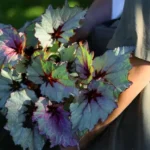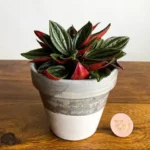1. What Is Araceae? Understanding the Aroid Family
The Araceae family—commonly called aroids—includes over 140 genera and approximately 3,700–4,000 species, mostly tropical plants (Pistils Nursery, Wikipedia) (Pistils Nursery). Characterized by their unique spadix and spathe flower structures, they are widely appreciated as ornamental houseplants.
Notable aroid genera include Monstera, Philodendron, Anthurium, Spathiphyllum (Peace Lily), Alocasia, Dieffenbachia, Rhaphidophora, etc. They are prized for bold foliage, easy care, and adaptability to indoor environments.
2. Core Care Principles for Aroids
2.1 Light
- Provide bright, indirect light—e.g., east or north-facing windows.
- Avoid direct afternoon sun which can scorch leaves.
- Too little light leads to slow growth and leggy stems (The Spruce, The Spruce).
2.2 Soil Mix
- Use a chunky, well-aerated potting medium: mix orchid bark, perlite, peat/lots of organic matter (Pistils Nursery) (Pistils Nursery).
- Avoid coco peat-only mixes—they retain too much moisture indoors, causing root-oxygen starvation (Aquarium Coop forum) (Aquarium Co-Op Forum).
2.3 Watering
- Allow the top 1–2″ soil to dry before watering again—this maintains evenly moist but not soggy conditions (Pistils Nursery) (Pistils Nursery).
- Overwatering leads to root rot; underwatering causes leaf curling or browning tips.
- Use distilled, filtered, or rainwater especially if local tap water is hard or high in fluoride/chlorine (BHG on Peace Lily brown tips) (Better Homes & Gardens).
2.4 Humidity & Temperature
- Most aroids thrive at 60–75°F (16–24 °C), and humidity between 50–70%, ideally above 60%.
- Low humidity causes crispy or brown leaf edges—use pebble trays, grouping, humidifiers as needed (Pistils Nursery, Aquarium Co-Op Forum).
2.5 Fertilizing
- During active growth (spring/summer): use dilute balanced or phosphorus-rich fertilizer (e.g., 10‑10‑10 or 3‑1‑2 formula) every 4–6 weeks or weekly at ¼ strength for Anthurium’s blooms (The Spruce) (The Spruce).
- Flush excess salts occasionally by running water through the potting medium.
2.6 Plant Maintenance
- Wipe leaves with a damp microfiber cloth to remove dust and help photosynthesis and pest prevention (The Spruce Anthurium care) (The Spruce).
- Prune yellowing or damaged leaves; repot every 1–2 years or when root-bound.
3. Species-Specific Care Examples
3.1 Monstera deliciosa (“Swiss Cheese Plant”)
- Watering: Water thoroughly then let the top 25–33% dry before next watering. Reduce frequency during winter (~every 2 weeks) (Almanac.com) (Almanac.com).
- Humidity: Benefit from regular misting or humidifier. Leaf edge browning often indicates dryness (Almanac.com) (Almanac.com).
- Light: Bright indirect but can tolerate medium light. Avoid scorching midday sun.
- Repotting & Propagation: Repot every ~2 years; propagate via stem cuttings with nodes in water or soil (Almanac.com) (Pistils Nursery).
3.2 Philodendron (e.g., P. gigas, Birkin, Pothos etc.)
- Water: Water when top inch is dry, especially for climbing varieties. Avoid soggy soil. (The Spruce) (The Spruce).
- Light & Soil: Use acidic, loose, well-draining mix; bright indirect light is ideal, though many tolerate lower light with slower growth (The Spruce) (The Spruce).
- Temperature & Humidity: Keep above 55°F; aim for humidity ≥ 60%; avoid drafts from HVAC or windows (Houseplant Resource Center) (Houseplant Resource Center).
3.3 Anthurium (Flamingo Flower)
- Light: ~6 hours of bright indirect light; too little light leads to fewer or no blooms, too much and leaves scorch (The Spruce) (The Spruce).
- Soil & Water: Use coarse mix (orchid bark, pumice, peat); keep consistently moist but never wet. Water until drainage but do not let sit (The Spruce) (The Spruce).
- Temperature & Humidity: Optimal range 65–85°F; humidity 60–75%. Use pebble trays or humidifier if dry air.
- Fertilizer: With phosphorus-rich liquid fertilizer weekly during bloom season; dust leaves gently monthly to support photosynthesis (The Spruce) (The Spruce).
3.4 Peace Lily (Spathiphyllum)
- Light: Tolerates low-to-medium light; brighter indirect light encourages blooms (Real Simple) (Real Simple).
- Water: Water when top inch feels dry. Drooping leaves usually revive within hours after watering (Southern Living) (Southern Living).
- Problems: Brown tips may indicate overwatering, underwatering, chemical in water, low humidity, overfertilizing, drafts, or natural leaf aging. Use filtered water, maintain humidity, feed sparingly every 4–6 weeks (BHG) (Better Homes & Gardens).
4. Common Issues & Their Fixes
4.1 Root Rot (Soft, yellowing, wilting foliage)
- Cause: waterlogged soil, poor drainage.
- Fix: repot into chunky, fast-draining mix; trim rotten roots; water less frequently (Better Homes & Gardens).
4.2 Leaves Yellowing or Curling
- Under- or over-watering, poor light, nutrient deficiency. Adjust watering, light, and soil. Consider fertilizing slightly during growth season.
4.3 Brown Leaf Tips or Edges
- Humidity too low, hard water, excess fertilizer, or too much direct sun
- Fix: increase ambient humidity (humidifier or pebble tray), flush roots, use filtered water, trim affected edges (The Spruce).
4.4 Leggy/Stretched Growth
- Too little light. Move to brighter spot, rotate plant periodically for uniform exposure; use supplemental grow lights if needed (Better Homes & Gardens).
4.5 Pests: Mealybugs, Scale, Spider Mites, Thrips
- Use neem oil or insecticidal soap sprays, targeting undersides of leaves. Repeat weekly for up to 3 weeks until pests clear (GreenboogGarden).
4.6 Fertilizer Burn
- Browning margins or wilting after fertilizing.
- Flush with water thoroughly to remove salts; reduce frequency and concentration.
5. FAQs (What People Often Ask)
Q1: Are aroids toxic?
Yes, most Araceae contain calcium oxalate crystals causing oral irritation, drooling, vomiting, and swelling if ingested—be cautious with pets and children, especially with Dieffenbachia and Peace Lily (Wikipedia, Real Simple Peace Lily) (Pistils Nursery, Real Simple).
Q2: How often should I water my peace lily/philodendron?
Peace Lily: when top inch dries. Philodendron: when top inch dry; less in winter. Always check soil rather than follow strict schedule (The Spruce, The Spruce Philodendron) (The Spruce).
Q3: Why aren’t my Anthuriums flowering?
Often due to too little indirect light, incorrect fertilizer, or low humidity. Provide bright-filtered light, phosphorus-rich feeding, and humidity above 60% (The Spruce Anthurium guide) (The Spruce).
Q4: Are aroids hard to grow?
Generally moderate—they tolerate some neglect but need consistent humidity, drainage, and right light. Variegated varieties require more care due to lower chlorophyll and slower growth (Aquarium Coop forum) (Aquarium Co-Op Forum
8. Recommended Reading & References
- Detailed aroid care and problem guide (Pistils Nursery) (Pistils Nursery)
- Philodendron and Anthurium care guides (The Spruce, The Spruce Anthurium) (The Spruce, The Spruce)
- Monstera care and propagation information (Almanac.com) (Almanac.com)
- Common houseplant issue fixes and pest prevention tips (BHG, Real Simple, Aquarium Coop Forum, Real Simple Peace Lily care, Aquarium Coop forum) (Aquarium Co-Op Forum)
- Brown tip causes for Peace Lily and their solutions (BHG Peace Lily brown tips) (Better Homes & Gardens)








